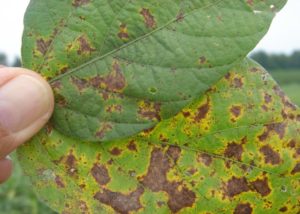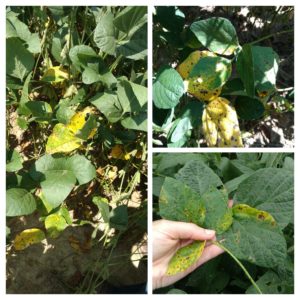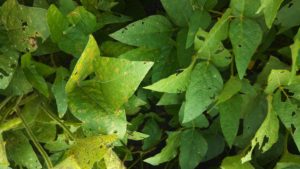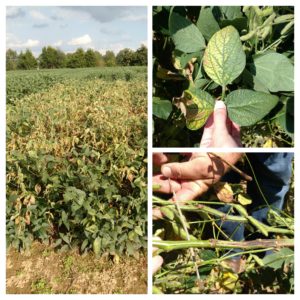This season has produced good looking soybeans as well as a bounty of diseases…
Soybean fields might be showing a number of diseases right now, dependent upon your field history, variety, and weather. I’ve seen septoria brown spot and target spot in lower canopies, frogeye leaf spot coming on strong on susceptible varieties on new/younger growth, and southern stem canker hurting yield on certain varieties. The mobile friendly field guide at guide.utcrops.com provides useful information on common soybean diseases.
Similar to last year, soybean rust has just been found in Giles County, at very low levels – 2 of 11 leaves with <1% severity from soybeans at R7 growth stage. This is the earliest soybean rust has been detected in Tennessee (Aug. 23, 2017, previously was Aug. 29, 2016). Later planted soybeans in middle Tennessee area that haven’t already gotten a fungicide application could benefit from one now to protect yield from soybean rust if they are earlier than R5.5.
The usual suspects in the lower canopy – septoria brown spot and target spot have not gotten as severe this season as seen in 2016. The extended period of wet, overcast days in 2016 promoted the progression of these 2 diseases up into the middle and upper canopies of some varieties. Foliar fungicides are not usual recommended to control just these diseases as they usually stay in the lower canopy and have little impact on yield, although this is dependent upon variety. As seen in 2016 some varieties are more susceptible to target spot, on-going research trials are evaluating fungicides efficacy for target spot and will be presented during winter production meetings throughout Tennessee. Varieties in the 2016 UT Disease Variety Trials were rated for target spot severity and can be found at search.utcrops.com/disease.



Frogeye leaf spot is one of the main yield robbing diseases in Tennessee. With the QoI/Strobilurin fungicide resistance that is prevalent in that pathogen, a solo QoI/Strobilurin (FRAC 11 group) fungicide application looks like an untreated field. Many combination products are still controlling frogeye, although on high disease pressure fields with susceptible varieties, frogeye leaf spot can still come on after a good R3 fungicide application, but will usually be after R5 and no additional fungicide application will be needed. It is recommended on “seed beans”, those fields producing seed that will be packaged and sold for planting, that 2 fungicide applications be applied, one at R3 and another at R5 to maintain seed quality.

Southern stem canker can easily be confused with sudden death syndrome (SDS), due to both diseases exhibiting yellowing (chlorosis) between leaf veins, but closer examination of the stem will show the difference, with stem canker having a dark brown-purplish lesion/canker on one side of the stem. Also, as plants die with stem cankers the dead leaves stay on the plant, where as plants with SDS leaves will usually fall off leaving just the petioles sticking out. Variety selection is most important when dealing with a field that has stem canker. Information collected from UT variety trials can be found at http://utcrops.com/soybean/varieties_soy.htm and in a searchable variety disease database at search.utcrops.com, which contains disease ratings on frogeye leaf spot, septoria brown spot, target spot, southern stem canker, sudden death syndrome, Cercospora leaf blight, and soybean cyst nematode as well as yields of varieties treated and non-treated with a fungicide at R3.
For additional information about diseases in soybean visit the mobile friendly field guide at guide.utcrops.com for disease descriptions, images, and management options.

